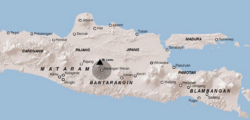Bantarangin Sunanate: Difference between revisions
No edit summary |
No edit summary |
||
| Line 32: | Line 32: | ||
|date_post = | |date_post = | ||
<!-- Flag navigation: Preceding and succeeding entities p1 to p5 and s1 to s5 --> | <!-- Flag navigation: Preceding and succeeding entities p1 to p5 and s1 to s5 --> | ||
|p1 = | |p1 = Demak Sultanate <!-- Name of the article for preceding entity, numbered 1-5 --> | ||
|flag_p1 = <!-- Default: "Flag of {{{p1}}}.svg" (size 30) --> | |flag_p1 = <!-- Default: "Flag of {{{p1}}}.svg" (size 30) --> | ||
|image_p1 = <!-- Use: [[File:Sin escudo.svg|20px|Image missing]] --> | |image_p1 = <!-- Use: [[File:Sin escudo.svg|20px|Image missing]] --> | ||
|p2 = | |p2 = Pajang Sultanate | ||
|flag_p2 = | |flag_p2 = | ||
|p3 = | |p3 = Majapahit Empire | ||
|flag_p3 = | |flag_p3 = | ||
|p4 = | |p4 = | ||
| Line 48: | Line 48: | ||
|s2 = Bantarangin Duchy | |s2 = Bantarangin Duchy | ||
|flag_s2 = | |flag_s2 = | ||
|s3 = | |s3 = Surakarta Sunanate | ||
|flag_s3 = | |flag_s3 = | ||
|s4 = | |s4 = Yogyakarta Sultanate | ||
|flag_s4 = | |flag_s4 = | ||
|s5 = | |s5 = Mangkunagaran Grand Duchy | ||
|flag_s5 = | |flag_s5 = | ||
|s6 = | |s6 = VOC | ||
|image_flag = [[File:Banner_of_Bantarangin_Sunanate.png|200px]] <!-- Default: Flag of {{{common_name}}}.svg --> | |image_flag = [[File:Banner_of_Bantarangin_Sunanate.png|200px]] <!-- Default: Flag of {{{common_name}}}.svg --> | ||
|flag_alt = <!-- Alt text for flag --> | |flag_alt = <!-- Alt text for flag --> | ||
Revision as of 01:22, 8 April 2020
Bantarangin Sunanate Kasunanan Bantarangin | |||||||||||||||||||||||
|---|---|---|---|---|---|---|---|---|---|---|---|---|---|---|---|---|---|---|---|---|---|---|---|
| 1517–1757 | |||||||||||||||||||||||
|
Flag | |||||||||||||||||||||||
| Motto: Mukti Digdaya Hangrungkebi | |||||||||||||||||||||||
 The Map of Bantarangin Sunanate during the reign of Hamangkuturana III or Panembahan Pakunata III | |||||||||||||||||||||||
| Capital | Sarangan Wetan (1517-1648) Liman (since 1648) | ||||||||||||||||||||||
| Common languages | |||||||||||||||||||||||
| Religion | Islam~78% Hindu~15% Kejawen~7% | ||||||||||||||||||||||
| Government | Pakuan (1517-1647)
Absolute monarchy Islamic | ||||||||||||||||||||||
| Susuhunan, Panembahan | |||||||||||||||||||||||
• 1517-1520 (First) | Hamangkuturana I | ||||||||||||||||||||||
• 1720-1757 (Last) | Pakunagara V | ||||||||||||||||||||||
| Pepatih Dalem | |||||||||||||||||||||||
• 1517-1518 (First) | Ki Wulu Cemeng | ||||||||||||||||||||||
• Last | Wiranagara VI | ||||||||||||||||||||||
| History | |||||||||||||||||||||||
• Pakuan Establishment | 1516 | ||||||||||||||||||||||
• Establishment | 1517 | ||||||||||||||||||||||
• Sabdaraja Sunan Anom Sriwijayan | 1525 | ||||||||||||||||||||||
• Liman Civil War | 1647-1648 | ||||||||||||||||||||||
• Sabdatama Pakunegaran | 1648 | ||||||||||||||||||||||
• Treaty of Sarangan | 1757 | ||||||||||||||||||||||
| |||||||||||||||||||||||
| Today part of | Indonesia | ||||||||||||||||||||||
Bantarangin Sunanate (Hanacaraka: ꦤꦒꦫꦶꦏꦱꦸꦤꦤ꧀ꦤꦤ꧀ꦧꦤ꧀ꦠꦫꦔꦶꦤ꧀), romanization: Nagari Kasunanan Bantarangin, Javanese pronounciation: /mbɑn:tɑrɑŋɪn/, was an independent kingdom located in the historical region Bantarangin, in the southeast slope of Mt. Lawu. The Sunanate was established by Ki Ageng Mertapa Turanawangsa, which later titled Hamangkuturana I (r. 1517-1520). It existed from the early 15th century until its dissolution in 18th century amid the Javanese Wars of Succession. The kingdom had played role in series of war such as Bantarangin-Demak-Pajang War, Second Geger Pakemuningan, and Javanese Wars of Succession along with their allies. Bantarangin reached its glorious and victorious peak during the reign of Hamangkuturana II (r. 1520-1540) and Pakunagara I (r. 1648-1679), in fact they lost their influence of power after the death of the Panembahan Pakunata IV (r. 1587-1607). They began to feel threatened by several uprisings in some nearby regions.
Etymology
The name "Bantarangin" was taken from a legend, in the era of Singhasari. The story told about the temptation between love and war, Prabu Kelanasenwandana the king of Bantarangin against Prabu Singabarong the king of Lodaya, they attempt and compete to gain Dewi Sanggalangit. The word "Sunanate" or "Kasunanan" (Javanese) was originally derived from Javanese root word "sunan" which means "the honored/admired/respected". This title is given by the Javanese and Sundanese to rulers, clerics and some even deities. A common usage is for the Nine Saints (Wali Songo), who were the spreaders of Islam in Java.
Geography
The kingdom shares its regions and borders with another duchies, regents, and small vassalry kingdoms. Ki Ageng Mertapa Tw. had chosen nearby Mt. Lawu because it was sacred at that time.
Heritage
Libraries
Books and manuscripts are also kept in Sarangan Wetan Keraton.
- Babad Bantarangin Vol I (Sunan Anom Sriwijayan)
- Babad Bantarangin Vol II (Panembahan/Sunan Sekti Aji Gibasan)
- Babad Bantarangin Vol III (Pakunata IV/Sunan Seda Pajang)
- Wangsa Turana (Sunan Sepuh Sriwijayan-Ki Ageng Lawu I, II, III)
- Pakuan Pakunata Turana (Sunan Sepuh Sriwijayan)
- Pakemuningan (Sunan Sepuh-Sunan Anom Sriwijayan)
Keris
There are some remaining heritage such as kris which is said still having strong supranatural power. Here the list some of the keris with the name of the owner:
- Keris Ajag Putih (Ki Ageng Mertapa Tw.)
- Keris Ajag Ireng (Ki Ageng Mertapa Tw.)
- Keris Ajag Cemeng (Ki Wulu Cemeng Tw.)
- Keris Ajag Geni (Ki Ageng Lawu)
- Keris Ajag Peteng (Ki Ageng Penjaten Tw.)
- Keris Ajag Gibas (Sunan Gibas)
- Keris Mpu Turana Putera (Sunan Anom Sriwijayan from Sang Aji Tp.)
- Keris Sasana Kulon (Untara Wijayantara, father of Sunan Anom)
- Keris Tapa Huna (Ki Ageng Penjaten Tw. from Ki Tapahuna)
- Keris Prabu Sri Genthayu
- Keris Prabu Kelanasenwandana
- Keris Prabu Singabarong
- Keris Sanggalangit
